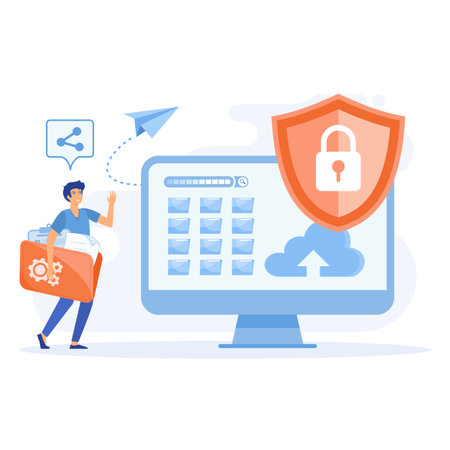1. Understanding the Security Landscape for U.S. E-Commerce
Staying Ahead of Threats in the American E-Commerce Market
Running an e-commerce business in the U.S. means more than just selling great products online. You also need to keep your platform and customer data safe from a range of cyber threats that are constantly evolving. Here’s an easy-to-understand overview of the most common security risks facing U.S. e-commerce platforms today.
Common Security Threats Explained
The digital world is full of bad actors who want to steal your data, scam your customers, or disrupt your business. The table below breaks down some of the top threats you should watch out for:
| Threat Type | What It Is | How It Impacts Your Business |
|---|---|---|
| Data Breaches | Unauthorized access to sensitive information like customer names, addresses, and credit card numbers. | Leads to loss of customer trust, possible legal issues, and financial penalties. |
| Phishing Attacks | Fake emails or websites tricking users into giving away passwords or payment info. | Puts both your customers and your business accounts at risk for theft and fraud. |
| Payment Fraud | Fraudulent transactions using stolen or fake payment details. | Can cause chargebacks, lost revenue, and damaged reputation. |
| Account Takeover (ATO) | Hackers gain control over a user’s account through stolen credentials. | Makes customers feel unsafe and can result in unauthorized purchases or data exposure. |
| DDoS Attacks | Overwhelming your website with traffic to make it crash or slow down. | Loses sales during downtime and frustrates customers trying to shop. |
The Rise of Payment Fraud Trends in the U.S.
The United States continues to see new trends in payment fraud, especially as more people shop online. Criminals are getting smarter by using advanced tools and techniques to bypass traditional security checks. From fake credit card numbers to stolen digital wallets, staying updated on these tactics is crucial for every e-commerce owner.
Your Role in Platform Security
If you run an e-commerce store, understanding these threats is the first step toward building a safer shopping environment. By knowing what you’re up against, you can take action to protect your business and keep your customers’ trust intact.
2. Regulatory Compliance: Meeting U.S. Standards
When running an e-commerce business in the United States, following specific laws and standards isn’t just a good idea—it’s a must. U.S. regulations like the California Consumer Privacy Act (CCPA) and Payment Card Industry Data Security Standard (PCI DSS) are designed to protect customer data and ensure your platform is safe from cyber threats. Let’s break down what these rules mean for your online store and why compliance matters for both legal reasons and earning your customers’ trust.
What Is CCPA?
The CCPA gives California residents more control over their personal information. Even if your business is not based in California, if you have customers there or meet certain thresholds (like $25 million in annual revenue), you need to comply. Under CCPA, customers can request to see, delete, or opt out of the sale of their data.
CCPA Key Requirements
| Requirement | What It Means |
|---|---|
| Notice at Collection | Tell customers what personal data you collect and why |
| Right to Access | Customers can ask for details about their data held by your business |
| Right to Delete | Customers can ask you to delete their personal information |
| Opt-Out Option | Customers can say no to the sale of their data |
Understanding PCI DSS
If you accept credit card payments, PCI DSS is your go-to standard. This set of rules helps make sure you handle payment info securely—from how you store card numbers to how you process transactions online. Non-compliance can lead to hefty fines from banks or card networks—and damage your reputation.
PCI DSS Main Points
| Main Area | Your Responsibility |
|---|---|
| Secure Network | Use firewalls and strong passwords |
| Protect Cardholder Data | Encrypt stored payment info |
| Monitor and Test Networks | Regularly check systems for security gaps |
| Maintain Security Policies | Train employees on safe payment processing practices |
The Benefits Go Beyond Fines—It’s About Trust
Complying with these standards doesn’t just help you avoid penalties. Customers today are wary of sharing their information online. When they see that your store takes privacy and security seriously, they’re more likely to shop with you and come back again. In short: meeting U.S. regulatory requirements protects both your business and your reputation in the market.

3. Best Practices for Safeguarding Customer Data
Why Protecting Customer Data Matters
As a U.S. e-commerce business, keeping your customers personal and payment information safe is not just about avoiding legal trouble—its about building trust and maintaining your reputation. Data breaches can lead to costly lawsuits, loss of customer confidence, and serious financial harm.
Actionable Steps to Secure Your Platform
1. Use Strong Encryption Everywhere
Encryption turns sensitive information into unreadable code. Make sure all personal and payment data is encrypted both when it’s sent (in transit) and when it’s stored (at rest). Modern e-commerce platforms often offer built-in encryption features, but always double-check that they’re enabled.
2. Choose Trusted Payment Gateways
Never store payment details directly on your site unless absolutely necessary. Instead, use secure third-party payment gateways like PayPal, Stripe, or Square. These companies invest heavily in security measures and help you meet industry standards like PCI DSS compliance.
| Payment Gateway | Security Features | PCI Compliance |
|---|---|---|
| PayPal | End-to-end encryption, fraud detection, buyer/seller protection | Yes |
| Stripe | Tokenization, real-time monitoring, 2FA for dashboard access | Yes |
| Square | Encryption at every touchpoint, secure hardware, dispute management | Yes |
3. Regularly Assess Vulnerabilities
Coding errors and outdated plugins are common ways hackers get in. Schedule regular vulnerability assessments—either by hiring a professional or using automated scanning tools—to find and fix weak spots before criminals do.
Simple Vulnerability Checklist:
- Update software/plugins: Always use the latest versions.
- Password policies: Require strong passwords and two-factor authentication (2FA).
- User permissions: Limit admin access to only those who need it.
- Monitor activity: Use logging tools to spot suspicious behavior early.
- Patching: Apply security patches as soon as they become available.
4. Educate Your Team and Customers
Your employees are your first line of defense. Train them to recognize phishing scams and practice good password hygiene. Also, let customers know how you protect their data and what steps they can take to stay safe while shopping online.
4. Implementing User Authentication and Access Controls
When running a U.S. e-commerce business, keeping your platform secure is more important than ever. One of the best ways to protect your business and customer data is by using strong user authentication and access controls. Let’s break down what this means in simple terms and explore practical ways you can boost security on your platform.
What Is User Authentication?
User authentication is all about making sure that only the right people can access certain parts of your e-commerce site. It’s like checking someone’s ID before letting them into a secure area. This process helps prevent unauthorized users from stealing sensitive information or causing damage to your business.
Multi-Factor Authentication (MFA)
MFA adds an extra layer of security beyond just a password. Instead of logging in with only a username and password, users must also provide another form of identification. This could be a code sent to their phone or generated by an app. Here’s a quick comparison:
| Authentication Method | Description | Security Level |
|---|---|---|
| Password Only | User enters a password to log in. | Basic |
| MFA (e.g., SMS code, authenticator app) | User enters password plus a second code from phone or app. | High |
Password Management Best Practices
- Encourage Strong Passwords: Require users to create passwords with a mix of letters, numbers, and symbols.
- Password Expiration: Ask users to update their passwords regularly.
- Avoid Password Reuse: Remind users not to use the same password across multiple sites.
- Use a Password Manager: Suggest password managers for storing complex passwords safely.
User Permission Strategies
You don’t want every employee or user to have access to everything on your e-commerce platform. By assigning permissions based on roles, you limit the risk if one account gets compromised. Here’s an example:
| User Role | Access Level | Examples of Permissions |
|---|---|---|
| Admin | Full Access | Add/remove products, view all orders, manage users |
| Staff/Seller | Limited Access | Edit own products, process orders, view sales reports |
| Customer Support | Restricted Access | View orders, assist customers, no product editing rights |
| Customer/User | Basic Access | Shop, make purchases, view own order history only |
Tips for Managing Permissions Safely:
- Review Roles Regularly: Check who has access and adjust as employees join or leave.
- Avoid Shared Accounts: Give each user their own login so activity can be tracked easily.
- Monitor Activity: Use logs to keep an eye on who does what within your system.
5. Fostering a Culture of Security Awareness
Why Security Awareness Matters for U.S. E-Commerce Businesses
Building a strong security culture is just as important as having the right technology. In the U.S., online shoppers expect you to protect their data. Training your team and educating your customers can help prevent security breaches, keep your reputation strong, and build trust with buyers.
Tips for Educating Your Team
- Regular Training: Host quarterly training sessions about recognizing phishing emails, handling customer information securely, and following password best practices.
- Clear Policies: Create easy-to-understand guidelines on how to manage sensitive data and respond to suspicious activity.
- Open Communication: Encourage employees to report anything unusual without fear of blame.
- Role-Based Access: Give access only to the data each team member needs to do their job.
Tips for Educating Your Customers
- Easy-to-Find Information: Add a “Security Tips” section on your website with advice on creating strong passwords and spotting scam emails.
- Email Alerts: Send periodic reminders about how you’ll communicate (e.g., “We’ll never ask for your password by email”) and what to do if they suspect fraud.
- User-Friendly Tools: Offer two-factor authentication (2FA) and explain how it works in simple terms.
Promoting Responsible Behavior: Quick Reference Table
| Who | What They Can Do | How You Can Help |
|---|---|---|
| Team Members | Avoid clicking suspicious links Create unique passwords Report odd activity fast |
Provide training Use password managers Create a clear reporting process |
| Customers | Use strong passwords Enable 2FA Avoid sharing sensitive info via email or text |
Email tips Add FAQs on your site Add alerts at login pages |
Responding Quickly to Incidents
- Create an Incident Plan: Make sure everyone knows what steps to take if there’s a data breach or suspicious activity—who to contact, what info to gather, and how to notify affected customers.
- Practice Drills: Run security drills twice a year so your team knows exactly what to do in an emergency.
- Keep Customers Updated: If something happens, tell customers quickly and clearly what you’re doing to fix it and how they can protect themselves.
A culture of security awareness keeps both your business and your customers safer. When everyone—from employees to shoppers—knows what to look out for, your platform becomes a much harder target for cybercriminals.

